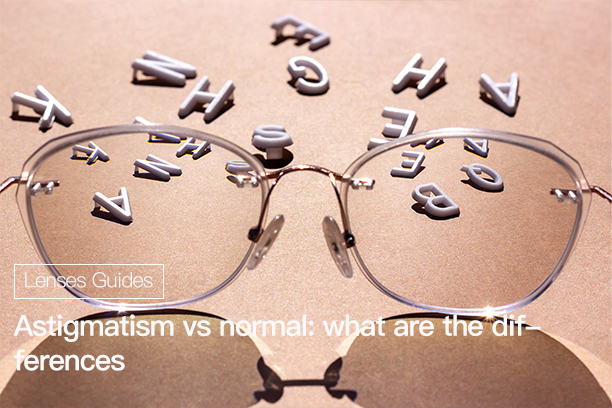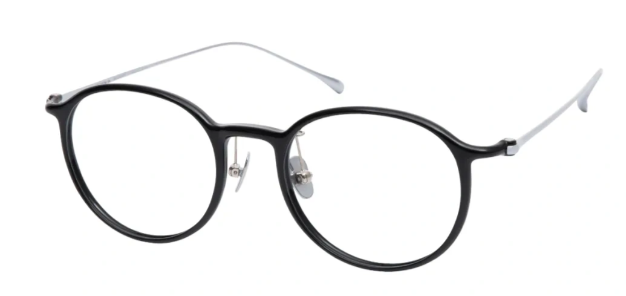- GlassesShop By FrameShop By StyleFeatured












When we talk about visual perception, two distinct states define how we perceive the world around us: astigmatism and normal vision. While normal vision is often taken for granted, astigmatism introduces unique optical characteristics that can influence clarity and focus.

Astigmatism is a refractive error of the eyes. It affects the eye focusing light onto the retina, and leads to blurred or distorted vision. Astigmatism occurs when the cornea or lens has an irregular shape. While for normal vision, the cornea and lens have a uniform curvature, and can focus light to a single point on the retina.Imagine the cornea (the clear front surface of the eye) as being shaped like a football rather than a perfectly round basketball. This irregular shape causes light to be focused at different points along two specific meridians or axes, like the two curves of the football. As a result, objects may appear blurry, stretched, or distorted in certain directions.Astigmatism can occur alongside other refractive errors like nearsightedness (myopia) or farsightedness (hyperopia). It can also exist on its own. There are two main types of astigmatism:
This type of astigmatism originates from an irregular shape of the cornea. It's the most common form and can be caused by genetics, injury, or certain eye conditions.
This type results from an irregular curvature of the eye's lens, which sits behind the cornea. It can be present at birth or develop over time due to factors like aging or injury. Astigmatism is measured in diopters, with the degree and orientation of the irregularities determining the prescription needed to correct it. To address astigmatism and provide clear vision, prescription eyeglasses, contact lenses, or refractive surgeries like LASIK can be prescribed. These corrective measures work by compensating for the uneven bending of light, redirecting it to a single focal point on the retina.Astigmatism is an imperfection of the eye focusing light because of the irregular shape of the cornea or lens. This leads to blurred or distorted vision, as light converges on multiple points on the retina rather than a single point. Fortunately, modern eyewear and corrective procedures can effectively address astigmatism, enabling those affected to enjoy improved visual clarity and quality of life.
Astigmatism arises from irregularities in the shape of the cornea or lens, which disrupt the eye's ability to focus light accurately onto the retina. These irregularities cause light to be refracted or bent unevenly, leading to distorted or blurred vision. While the precise cause of astigmatism can vary, several factors contribute to its development:
One of the primary causes of astigmatism is an irregularly shaped cornea. Instead of having a smooth, evenly curved surface like a basketball, the cornea might resemble the shape of a football. This will cause light to be focused at multiple points on the retina rather than a single one.
Genetics plays a significant role in the development of astigmatism. The possibility to have similar symptoms will increase if one of your family members has astigmatism. Genetic factors can influence the overall shape and structure of the eye.
Trauma or injuries to the eye can alter the cornea's shape, potentially leading to astigmatism. Surgical procedures involving the eye, such as corneal transplant surgeries, can also induce astigmatism if the healing process results in an irregular corneal curvature.
The lens, which sits behind the cornea, can also contribute to astigmatism if it has an irregular shape. This can be caused by genetic factors or changes in the lens due to aging or certain eye conditions.
Keratoconus is a progressive eye disorder in which the cornea thins and bulges into a cone-like shape. This irregular curvature leads to astigmatism and visual distortion.
As we age, changes in the lens and cornea can occur. These age-related changes might accelerate the development of astigmatism.
Certain eye conditions or diseases, such as pellucid marginal degeneration or scarring from eye infections, can lead to corneal irregularities and subsequently cause astigmatism.
Excessive rubbing of the eyes, particularly during childhood, can potentially alter the corneal shape and contribute to astigmatism development.
Astigmatism is a common vision condition that can affect individuals of all ages. It's characterized by an irregular shape of the cornea or lens, which leads to blurred or distorted vision. Identifying the symptoms of astigmatism is essential for prompt diagnosis and appropriate corrective measures. Here are the common symptoms of astigmatism explained:
Blurred vision is the hallmark symptom of astigmatism. It occurs because the irregular cornea or lens shape causes light to be focused on multiple points on the retina, rather than a single, clear point. This results in a lack of sharpness and clarity in vision.
Astigmatism can cause objects to appear stretched or distorted. Straight lines may appear wavy, and shapes may not look as they should. This distortion occurs due to the uneven bending of light entering the eye.
Prolonged focusing on blurred or distorted images can lead to eye strain and discomfort. After intense visual concentration, such as reading or using a computer, individuals with astigmatism may have headaches and eye fatigue.
Astigmatism can worsen in low-light conditions, making night driving or activities in dimly lit environments challenging. Glare, halos, and poor contrast sensitivity may be more pronounced.
Squinting is a natural response to astigmatism. By partially closing the eyelids, individuals with astigmatism attempt to reduce the size of the irregular aperture, which can temporarily improve focus and clarity.
In some cases, astigmatism can lead to double vision (diplopia), where a single object appears as two overlapping or side-by-side images. This occurs when light entering the eye is split and focused on different points on the retina.
Astigmatism can affect the ability to see fine details clearly. Reading small print, working on intricate tasks, or recognizing facial features from a distance may be more challenging.
Individuals with astigmatism may notice frequent changes in their eyeglass or contact lens prescriptions as the condition progresses or stabilizes. Regular eye examinations are crucial to monitor and adjust prescriptions as needed.
Astigmatism and normal vision represent two distinct ways our eyes perceive the world around us. Understanding the differences between these two states is key to appreciating how the intricacies of our eyes' structures influence the quality of our sight. Here are an exhaustive comparison between astigmatism and normal vision:
Normal Vision: In normal vision, the cornea has a uniformly curved surface, much like a regular basketball.
Astigmatism: The cornea is shaped like a football or the back of a spoon.
Normal Vision: Light rays entering the eye converge to a single, precise point on the retina, resulting in a clear and focused image.
Astigmatism: Due to the uneven corneal curvature, light rays focus on multiple points (often two), causing blurred or distorted vision.
Normal Vision: Objects and shapes are perceived clearly and accurately, with no distortion.
Astigmatism: Objects may appear elongated, tilted, or stretched, affecting the perception of their true proportions.
Normal Vision: Individuals with normal vision experience sharp and focused vision.
Astigmatism: Astigmatism leads to varying degrees of blurred vision, affecting both near and distant objects.
Normal Vision: No corrective measures are needed for clear vision.
Astigmatism: Glasses, contact lenses, or corrective surgeries like LASIK can be prescribed to redirect light and improve visual clarity.
Normal Vision: Normal vision typically does not cause eye strain or discomfort.
Astigmatism: Astigmatism can lead to eye strain, headaches, and discomfort, especially after prolonged visual tasks.
Normal Vision: Visual distortions are minimal in normal vision.
Astigmatism: Astigmatism may cause visual distortions, impacting accurate perception of shapes and objects.

If you're seeking eyeglasses that cater to astigmatism while keeping you stylish, EFE has an array of options designed to provide both visual correction and fashionable appeal. Here are three noteworthy picks from EFE's eyeglasses collection that stand out for individuals with astigmatism:
1.E08405D

This rectangle glasses offer a timeless design that complements various face shapes. The rectangular shape provides a wide field of vision, and the black pattern adds visual interest. The adjustable nose pads ensure a comfortable fit, catering to astigmatism while maintaining a classic look.
2.E09153A

This modern square glasses combine style with functionality. The metal accents on the frame add a contemporary touch, while the shape offers a balanced fit. The option for prescription lenses addresses astigmatism needs while keeping you on-trend.
3.E08753A

These round glasses feature a lightweight titanium frame that ensures both durability and comfort. The round shape is particularly suitable for individuals with astigmatism as it offers a wider visual field. The minimalist design adds a touch of elegance to your look.
When selecting glasses for astigmatism, it's important to consider your prescription needs and personal style. These picks from EFE provide a diverse range of options that can enhance your visual clarity and complement your overall appearance. Remember to consult with an eye care professional to ensure accurate prescription lenses for your astigmatism correction.
In astigmatic eyes, the cornea or lens is irregularly shaped, causing light to focus unevenly on the retina, resulting in blurred or distorted vision. In contrast, the symmetrical shape of a normal eye allows light to focus clearly on the retina, resulting in clear vision.
Yes, astigmatism can occur in people with normal vision. Regular eye exams are critical to detecting any changes in vision and managing them appropriately, whether through corrective lenses or other treatment options.
Signs and symptoms of astigmatism may include:
- Blurred or distorted vision.
- Eyestrain or discomfort.
- Headaches.
- Difficulty with night vision.
- Squinting.
Astigmatism is diagnosed with an eye exam. A complete eye exam involves both a series of tests to check eye health and a refraction, which determines how the eyes bend light. Your eye doctor may use various instruments, aim bright lights directly at your eyes and ask you to look through several lenses.

